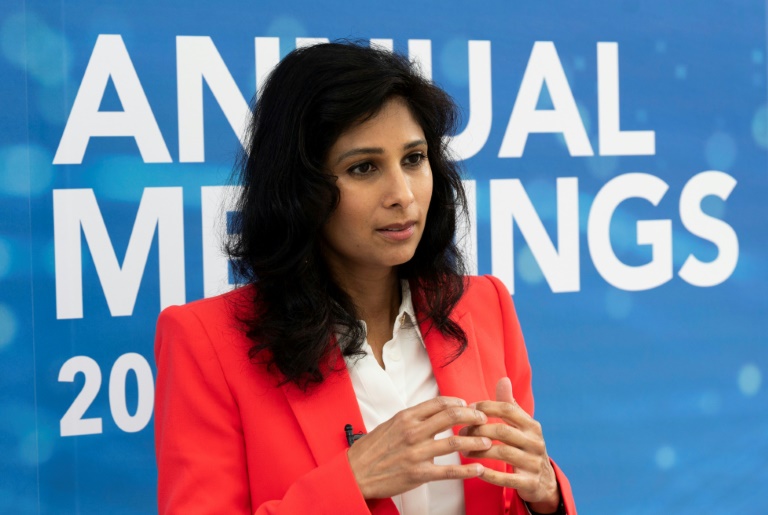The International Monetary Fund warns that the pandemic continues to slow the global economic recovery
4 min read

Gita Gopinath, chief economist at the International Monetary Fund, in a photo from October 13, 2020 in Washington, DC – AFP
The International Monetary Fund (IMF) warned on Tuesday (12) that the persistence of the COVID-19 epidemic and the uneven distribution of vaccines continue to slow the recovery of the global economy and worsen the prospects for developing countries, including Latin American countries.
Global growth for 2021 is expected to be 5.9%, down from the 6% estimated in July, a “marginal” decline, as the International Monetary Fund explained in its quarterly World Economic Outlook (WEO) update.
But these numbers mask significant setbacks in some countries, warned Gita Gopinath, chief economist at the International Monetary Fund, noting that “the outlook for the group of low-income developing countries has significantly deteriorated due to the worsening dynamics of the epidemic.”
Added to the delta-changing wave of coronavirus infections is a marked decrease in the vaccination rate in developing countries.
About 58% of the population of advanced economies is already fully immunized, compared to 36% in emerging economies and less than 5% in poor countries, according to the International Monetary Fund, which publishes its forecasts in the framework of annual meetings with the World Bank this week. Washington.
Another global challenge is logistical bottlenecks that have left global supply chains out of sync, leading to clogging of ports, shortages of a variety of products and rising export costs.
– Reduction for the United States of America, Brazil and Mexico –
As a result, the International Monetary Fund cut its 2021 growth forecast for the world’s largest economy – to 6% from 7% in July. But it adjusted upwards for 2022, at 5.2%, taking into account spending projects planned by the Joe Biden administration in several trillions of dollars.
In contrast, the Fund revised its growth forecast for 2021 in the euro area upwards (+0.4 points to 5%).
In this case, again, the disparities are large, with an increase in its growth estimate for France (+0.5 points, to 6.3%), thanks to an acceleration of vaccination of its population, and a decrease for Germany, which has a scarcity of semiconductors (-0.5 points, to 3.1%).
He said that China, the second economic power in the world where the epidemic began in late 2019, will continue to drive global growth (-0.1 points, to 8%) along with the United States and India (9.5%, unchanged). .
For Latin America and the Caribbean, a region severely affected by the epidemic, the fund has improved its growth forecast for this year (+0.5 points, to 6.3%), after a strong recession recorded in 2020 (-7% versus -3.1% globally). ).
But he downplayed expectations for Brazil and Mexico, the region’s two major economies, estimating GDP expansion of 5.2% and 6.2%, respectively, in both cases 0.1 percentage point lower than previously provided.
For 2022, the International Monetary Fund has maintained its global growth estimate at 4.9%.
However, Gopinath said that all these forecasts are still very uncertain, noting that they are based, in particular, on a target of vaccinating 40% of the world’s population by the end of this year and 70% for the first half of 2022.
– ‘Dangerous spacing’ –
For Gopinath, it is very clear that “a pandemic will not end in one place until it is finished everywhere.”
He warned that a prolonged recession “could reduce global GDP by an accumulated $5.3 trillion over the next five years.”
For the IMF’s chief economist, the biggest concern is the “serious difference” in economic prospects between countries.
The GDP of advanced economies is expected to return to its pre-pandemic trajectory in 2022.
But the GDP of emerging market and developing economies (excluding China) is expected to remain 5.5% below the pre-pandemic forecast in 2024, resulting in a “significant decrease in the improvement of living standards” for this population.
Moreover, “food prices are higher than others in low-income countries, where food insecurity is most severe, burdening the poorest households and increasing the risk of social unrest,” Gopinath noted.
However, the International Monetary Fund estimates that inflation will return to pre-pandemic levels by the middle of next year, in both advanced and emerging economies.
For the institution, the absolute priority remains epidemic control.
Gopinath concluded that “the international community must redouble its efforts to ensure equitable access to vaccines for all countries, overcome skepticism about vaccines when there are adequate supplies, and ensure better economic prospects for all.”
know more
+ The wife shares her husband with her mother and younger sister: “When I’m not in the mood”
In the sexy pose, Cleo Perez says: “I love my big ass”
+ Doctors find a piece of cement in the patient’s heart during surgery
+ The shark was caught in MA with the remains of the young lost in the stomach
+ Everything you need to know before buying a cooking pot
US agency warns: Never wash raw chicken
+ Attacks passengers and pulls out a host’s teeth
+ Aloe vera gel in the drink: see the benefits
+ Lemon Squeeze Trick Goes Crazy On Social Media
+ Yasmine Brunet breaks the silence

“Entrepreneur. Music enthusiast. Lifelong communicator. General coffee aficionado. Internet scholar.”







